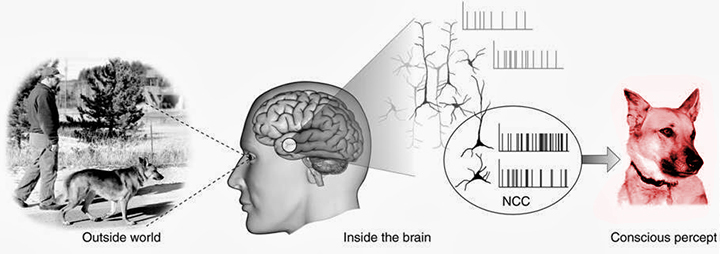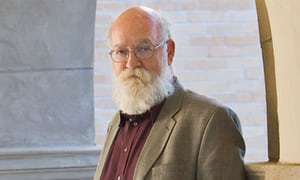Dan Dennett is a materialist. Dualists think that there are two kinds of things in the world—mind and body. Dennett thinks there is only one, and it ain’t mind. Though he’s a fine writer, it can be hard to understand exactly what he thinks the mind amounts to. His books are entertaining, but long, and his point sometimes gets a little lost in his fascinating discussions of Darwin, memes, bacteria, Bach, and you name it.
A recent paper “Why and How Does Consciousness Seem the Way it Seems” (2015 https://open-mind.net/DOI?isbn=9783958570245) is more succinct. While Dennett does not mention Christof Koch, what he does say would mean that the dualism inherent in Koch’s approach cannot be right. The contrast between the two is illuminating for both.
Let’s take another look at Koch’s diagram, which represents a man focused on seeing a dog:

The timeline is left to right. As Dennett puts it, “The arrival of photons on the retina is transduced thanks to rhodopsin in the rods and cones, to yield spike trains in the optic nerve (I’m simplifying, of course).” The spike trains are represented by the bar code symbols. They set off what must be dizzyingly complex patterns of neuron firings. Some of those patterns become Neural Correlates of Consciousness. Those NCCs somehow cause or underlie or induce the immaterial Conscious Percept of the dog. The causal event is represented by the arrow on the right. In Koch’s view,
A science of consciousness must strive to explain the exact relationship between phenomenal, mental states and brain states. This is the heart of the classical mind-body problem: What is the nature of the relationship between the immaterial, conscious mind and its physical basis in the electrochemical interactions in the body? … Every phenomenal, subjective state will have associated Neural Correlates of Consciousness: one for seeing a red patch, another one for seeing grandmother, yet a third one for hearing a siren, etc.(http://www.scholarpedia.org/article/Neural_correlates_of_consciousness)
Koch’s view is dualistic. There are two dogs in the diagram: the real, physical dog in the Outside World and the immaterial image of a dog in the Conscious Percept. There are also two transductions: the first changes photons reflcted off the dog into neural impulses, the second changes to the resulting brain patterns into a Conscious Percept of the dog. The physical world is to the right of the arrow; everything you experience or could experience—your entire world as experienced—lies to the right of the arrow. This means that you never experience the Outside World directly, but only via the immaterial Conscious Percepts (qualia, or Russell’s sense-data).
Koch’s view is not Cartesian dualism, because the mind cannot exist independently of the NCCs. There is no immortal soul that can float away from the brain. Koch’s view does commit him to a kind of dualism, however, and one that can seem fairly plausible.
Anyone who believes that consciousness exists and has a scientific basis must believe in that second transduction. Unless you believe that your consciousness is endowed on you by God from moment to moment, it must come from your brain. That’s the second transduction.
Dennett rejects the second transduction. “There is no double transduction in the brain. Therefore there is no second medium, the medium of consciousness or, as I like to call this imaginary phenomenon, the MEdium. Therefore, qualia, conceived of as states of this imaginary medium, do not exist.” What Koch shows as the Conscious Percept—the explanation of which is the point of neuroscience—Dennett rejects entirely as an imaginary phenomenon. There is nothing to the right of the arrow; in fact, there is no arrow.
Spike trains are discriminated, elaborated, processed, reverberated, reentered, combined, compared, and contrasted— but not transduced into anything else until some of them activate effectors (neuromuscular junctions, hormone releasers, and the like) which do the physical work of guiding the body through life. The rich and complex interplay between neurons, hundreds of neuromodulators, and hormones is now recognized, thanks to the persuasive work of Damasio and many others, as a central feature of cognition and not just bodily control, and one can speak of these interactions as transduction back and forth between different media (voltage differences and biochemical accumulations, for instance)—but none of these is the imagined MEdium of subjective experience.
Without that second transduction, there can be no consciousness, no subjective experience. This really is The Astonishing Hypothesis, which Francis Crick suggests, but then quickly backs away from. In BQTA post “Materialist Don’t Mean It: the Dualism of Crick and Koch” we argued that although Crick claims that your mental life is “in fact no more than the behavior of a vast assembly of nerve cells and their associated molecules,” what he really means is that your mental life is caused by the behavior of a vast assembly of nerve cells and their associated molecules. That’s a form of dualism.
By contrast, Dennett is a materialist who means it.
There is no second transduction. And if there were, there would have to be a third transduction, back into spike trains, to account for our ability to judge and act on the basis of our subjective experiences. There might have been such triple transductions, and then there would have been a Cartesian Theater Deluxe, like the wonderful control room in the film Men in Black. But biology has been thrifty in us: it’s all done through the medium of spike trains in neurons.
Yikes! A third transduction? Dennett has a point. If the immaterial Conscious Percept has a purpose, it’s to help the guy judge things like what kind of a dog he’s looking at, and what color it is. Those thought processes require their own spike trains. So there would have to be another arrow pointing in the opposite direction—from the Conscious Percept back into the brain so that consciousness could cause something to happen in the physical world. This is the essence of the objection Princess Elizabeth put to Descartes in 1643. She said she cannot “understand the idea through which we must judge how the soul (nonextended and immaterial) is able to move the body, that is, by that idea through which you have at another time understood heaviness … And I admit that it would be easier for me to concede matter and extension to the mind than it would be for me to concede the capacity to move a body and be moved by one to an immaterial thing.” The question remains better than any available answer.
Dennett elaborates his point with a thought experiment.
Suppose we have a drone aircraft hunting for targets to shoot at, and suppose that the drone is equipped with a safety device that is constantly on the lookout for red crosses on buildings or vehicles—we don’t want it shooting at ambulances or field hospitals! With its video eye it takes in and transduces (into digital bit streams) thirty frames a second (let’s suppose) and scans each frame for a red cross (among other things). Does it have to project the frame onto a screen, transducing bit streams into colored pixels? Of course not. It can make judgments based on un-transduced information—in fact, it can’t make judgments based on anything else.
Dennett is right about the drone. It’s not conscious;. There is a first transduction in the drone to create the electrical impulses its on-board computers work with. No second or third transductions needed or wanted. The drone spots the “red” in the red cross by analyzing the wavelength of the light from the ground. The drone has no color experience (or any other kind of experience). It stays entirely in the physical world, where color does not exist. (See BQTA post “The Science of Color”). But gee Dan, doesn’t this show the difference between humans and drones? We do have color experiences. Dennett is undeterred:
Similarly your brain can make judgments to the effect that there is a red stripe out there on the basis of spike train patterns in in your cortex, and then act on that judgment (by causing the subject to declare “I seem to see a red stripe,” or by adjusting an internal inventory of things in the neighborhood, or…). They are not qualia, in other words. Qualia—as typicaly conceived—would only get in the way. Don’t put a weighty LED pixel screen in a drone if you want it to detect red crosses, and don’t bother installing qualia in a brain if you want it to have color vision. Whatever they are, qualia are unnecesary and may be jettisoned without loss.
Here Dennett shows the behaviorism in his thinking. There is nothing to having a mental state other than being able to produce the right behavior, such as “causing the subject to declare ‘I seem to see a red stripe.’” But we want to say, “I didn’t just say it, I experienced it!”
Color is our paradigm for non-physical qualia:
Neither objects nor lights are actually ‘colored’ in anything like the way we experience them. Rather, color is a psychological property of our visual experiences when we look at objects and lights, not a physical property of those objects or lights. The colors we see are based on physical properties of objects and lights that cause us to see them as colored, to be sure, but these physical properties are different in important ways from the colors we perceive. (Palmer, Vision Science, Photons to Phenomenology MIT 1999, p. 95)
Color is in the mind of the viewer (thus psychological), not in light (the physical) or even in the eye’s photoreceptors, which create from light the essential biological signals for seeing… color is a product of the mind… (Shevell, The Handbook of Color Psychology CUP 2015)
There’s no color in the “red” cross or in the light reflected from it. No problem for the drone, which operates with what’s in the physical world: wavelength information. No color involved. But color is involved for us! Dennett does not explain how he gets color without installing qualia.
I think the drone example cuts against Dennett’s argument. At least Dennett does not shy away from the consequences of his position. This is hard-core materialism.






